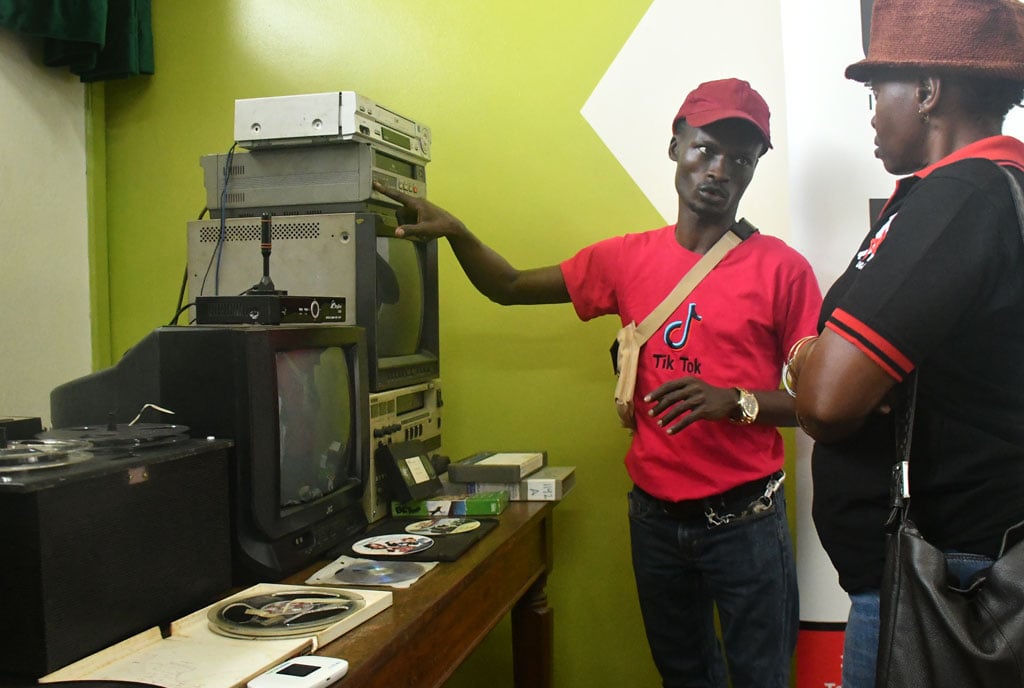Prime
How local museums can hold off existential threat

An employee of Uganda Broadcasting Corporation (UBC) shows a woman some of the equipment that UBC has used over the years during International Museum Day celebrations in Kampala last year. PHOTO/ EDGAR R. BATTE
What you need to know:
- According to the European Museums Survey Report 2022, one in 10 museums have completed an analysis of challenges associated with climate change in the place they are domiciled.
“Trees are associated with our heritage. Looking at the environmental destruction going on, there is need to restore traditionally very important species of trees attached to our heritage,” Mr Francis Noono, a curator at the National Memory and Peace Documentation Museum in Kitgum District, explains.
He adds: “In post-conflict Acholi, some tree species are used for blessings and traditional reconciliation between two parties. We call it mato-oput.”
The initiative Mr Noono speaks so passionately about was started in 2011 by the Refugee Law Project. Fittingly, it is in line with the theme for this year’s International Museums Day—“Museums, Sustainability and Well-Being.”
According to the European Museums Survey Report 2022, one in 10 museums have completed an analysis of challenges associated with climate change in the place they are domiciled. The report further offers that only three in 10 museums have analysed the climate impacts they are likely to be challenged by.
“Our museums can address some of these challenges in different ways,” Mr Fredrick Nsibambi, the deputy executive director at The Cross-Cultural Foundation of Uganda, opines, adding that this can be achieved by “curating exhibitions that highlight the effects of climate change or how to mitigate climate change, gender-based violence or poverty.”
He further offers that “museums can use their spaces to disseminate information about good governance and accountability from our traditional perspectives; promote intercultural dialogue and conflict management by allowing different cultures to ‘quietly communicate’ with each other.”
Ms Alice Kibombo Ekanya, a media communications practitioner, reckons Uganda needs to find a way of intersecting its efforts with the Sustainable Development Goals (SDGs). She hastens to point out that museums primarily collect heritage objects from community forests as elements of nature.
“Uganda, like any other country, has been affected by climate change and by climate change, we not only mean the rains, the thunderstorm and the like, but there is also the political and social economic environment,” she notes, adding, “We need to operate in a way that is relevant to the needs of our people.”
When Mr Samuel Alfred Kizaalwa was born a little over 50 years ago, his parents relied on forests and the environment for their medicinal needs, food and well-being. He is irked that today people are depleting forests, rivers and the natural environment.
“Should we be surprised that nature is turning against us?” Mr Kizaalwa, an assistant commissioner at the Department of Museums, asks rather rhetorically, “The three SDGs of health, climate action and life on land are interrelated.”
He adds: “When you talk about museums sustainability and the wellbeing of people, it implies that people must be healthy and if they are to be healthy, they must use the environment around them and the environment around them includes the conservation of the nature around them. We took this year’s day celebrations to Gulu because there has been a wide clearing of forests for charcoal.”
Ms Maureen Mutonyi Kiyaga, the heritage officer at Uganda National Cultural Centre, whose mandate is to promote art and culture, says the institution has undertaken research and education through partnerships with organisations and people who have interest in heritage. She notes that museums are an important part of the information ecosystem because they hold many artefacts, collections – information which they hold in trust for the community.
In the face of a dynamic society, Mr Nsibambi asks, “How can museums in Uganda contribute to efforts to address our contemporary challenges?”
Today, he adds, “Uganda is grappling with a myriad of development challenges such as poverty, hunger and food insecurity, limited access to health facilities, gender-based violence, climate change-induced disasters such as floods and landslides, injustice and conflicts.”
Adaptability
The dynamism of culture is a reality today where cultures keep evolving to suit the interests of current generations and to ensure their survival by being appreciated by the young generation.
To this end, Mr Nsibambi says young people—the future leaders—will not find cultures appealing once they are frozen in time and space. This, he further says, applies to museums too. If they remain stuck in the past without providing spaces for addressing contemporary development challenges, they risk remaining mere monuments.
“Therefore, as we commemorate this year’s International Museum Day, the capacity of museums to actively participate and invest in programmes that can address our development challenges should be enhanced,” he advised last Thursday, adding of the museums, “They need to rigorously invest in concerts, films, lectures, shops and workshops with the aim of creating employment and income-generating enterprises.”
International Museum Day
Uganda has since 1977 joined the world in commemorating International Museum Day. It does this under the auspices of the International Council of Museums (ICOM), a network of all museums in the world. The day—celebrated each May 18—provides opportunities to celebrate museums as key actors in promoting the well-being and sustainable development of our communities.
According to ICOM, a museum is a not-for-profit, permanent institution in the service of society that researches, collects, conserves, interprets and exhibits tangible and intangible heritage. Uganda has tens of museums, with the Uganda Museum—backed by an ethnography section with hundreds of thousands of artefacts—a standout performer.





